Statistics/da: Difference between revisions
From LimeSurvey Manual
Maren.fritz (talk | contribs) (Created page with "* '''Afsendelsesdato:'''Vises kun, hvis timings er aktiveret. Du kan filtrere dataene baseret på indsendelsesdatoen for dine indsamled...") |
Maren.fritz (talk | contribs) (Created page with "===Svarfiltre===") |
||
| Line 102: | Line 102: | ||
For kun at få svarene filtreret i henhold til '''generelle filtre''', skal du aktivere indstillingen "Se oversigt over alle tilgængelige felter" og klikke på knappen '''Se statistik''', som er placeret i øverste højre del af skærmen. | For kun at få svarene filtreret i henhold til '''generelle filtre''', skal du aktivere indstillingen "Se oversigt over alle tilgængelige felter" og klikke på knappen '''Se statistik''', som er placeret i øverste højre del af skærmen. | ||
=== | ===Svarfiltre=== | ||
Afhængigt af den anvendte [[Spørgsmålstyper|spørgsmålstype]], kan forskellige felter bruges til at filtrere dine svar: | |||
* '''By response:''' Click one or more responses in the list under each question to filter the data by those responses (use CTRL/click to select multiple responses in the same question). Note that if you choose to view the summary of all available fields (checkbox at top) you will need to select your response filters before checking that box. | * '''By response:''' Click one or more responses in the list under each question to filter the data by those responses (use CTRL/click to select multiple responses in the same question). Note that if you choose to view the summary of all available fields (checkbox at top) you will need to select your response filters before checking that box. | ||
Revision as of 14:57, 2 January 2024
Generelt
Formålet med en undersøgelse er at "få svar på spørgsmål". Når du har oprettet, aktiveret og inviteret deltagere til at gennemføre din undersøgelse, kan du bruge Responses & Statistics-funktionen til at indsamle og analysere undersøgelsesresultater for at få svar.
Statistikfunktionen er placeret under svarmenuen i en aktiv undersøgelse: Svar > Svar og statistik Svar er kun tilgængelig, hvis en undersøgelse er blevet aktiveret.

Klik på Statistik på den øverste værktøjslinje.

Den følgende side vil blive vist.

LimeSurvey-statistikken kan vises i enten eksperttilstand eller simpel tilstand. Som standard vises eksperttilstand, når du klikker på Statistics
Statistik - eksperttilstand
Din undersøgelse er færdig, og du vil nu begynde at analysere resultaterne. LimeSurvey kan eksportere alle resultaterne til et Excel-regneark eller CSV-fil.
Funktionen statistik - eksperttilstand giver dig mulighed for at 'filtrere' dine data og hente tal og opsummeringer af forskellige felter. Statistikscriptet udfører ikke særlig kompliceret filtrering, men der er en masse meget nyttig information, som nemt kan fås.
Kører hurtig statistik
På skærmbilledet nedenfor kan du se, at der er et afkrydsningsfelt for hvert spørgsmål, der kan vælges for at vise en svaroversigt for hvert spørgsmål og et ikon, der, når du klikker på det (eller hvis musen svæver over det), giver dig spørgsmålets fulde tekst. For at se resultaterne for et eller flere spørgsmål, skal du markere afkrydsningsfeltet(e) øverst på spørgsmålene og derefter klikke på "Se statistik".
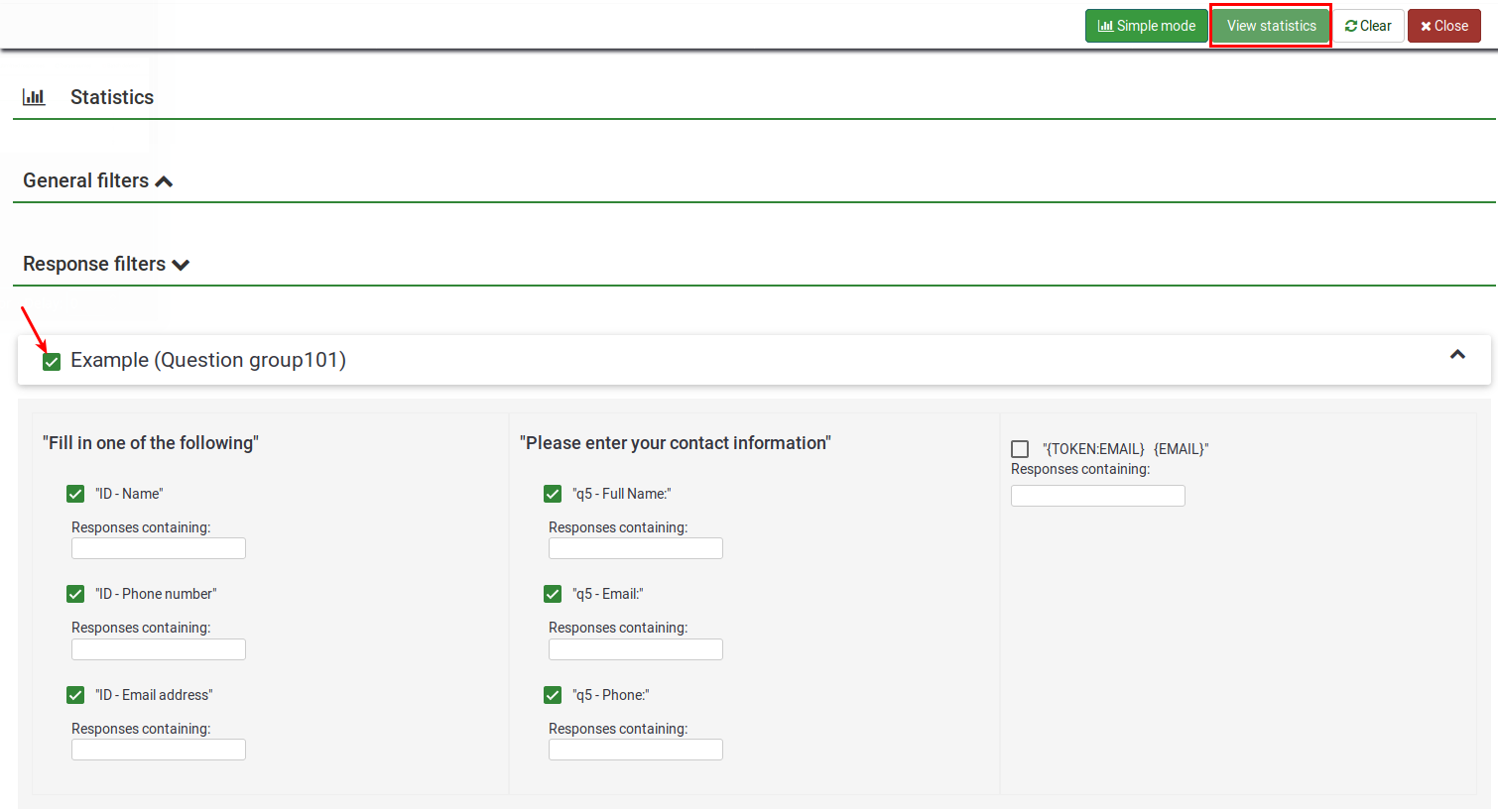
Alternativt, for at se resultaterne for alle tilgængelige spørgsmål, skal du aktivere "Se oversigt over alle tilgængelige felter" og derefter klikke på "Se statistik".
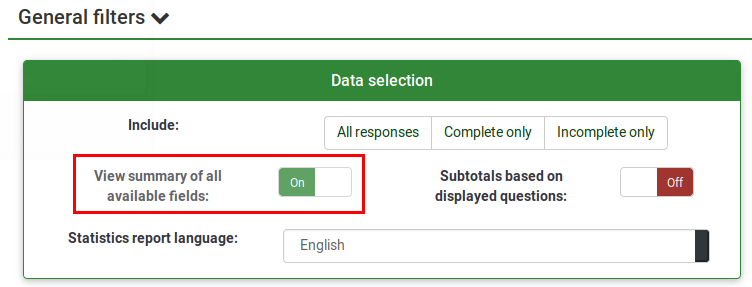
Du vil derefter få en "Resultater"-tabel, som vil angive antallet af sager og en "Feltoversigt"-tabel for hvert valgt spørgsmål, som opsummerer alle mulige svar i spørgsmålet/spørgsmålene, deres totaler og deres tilsvarende procent.
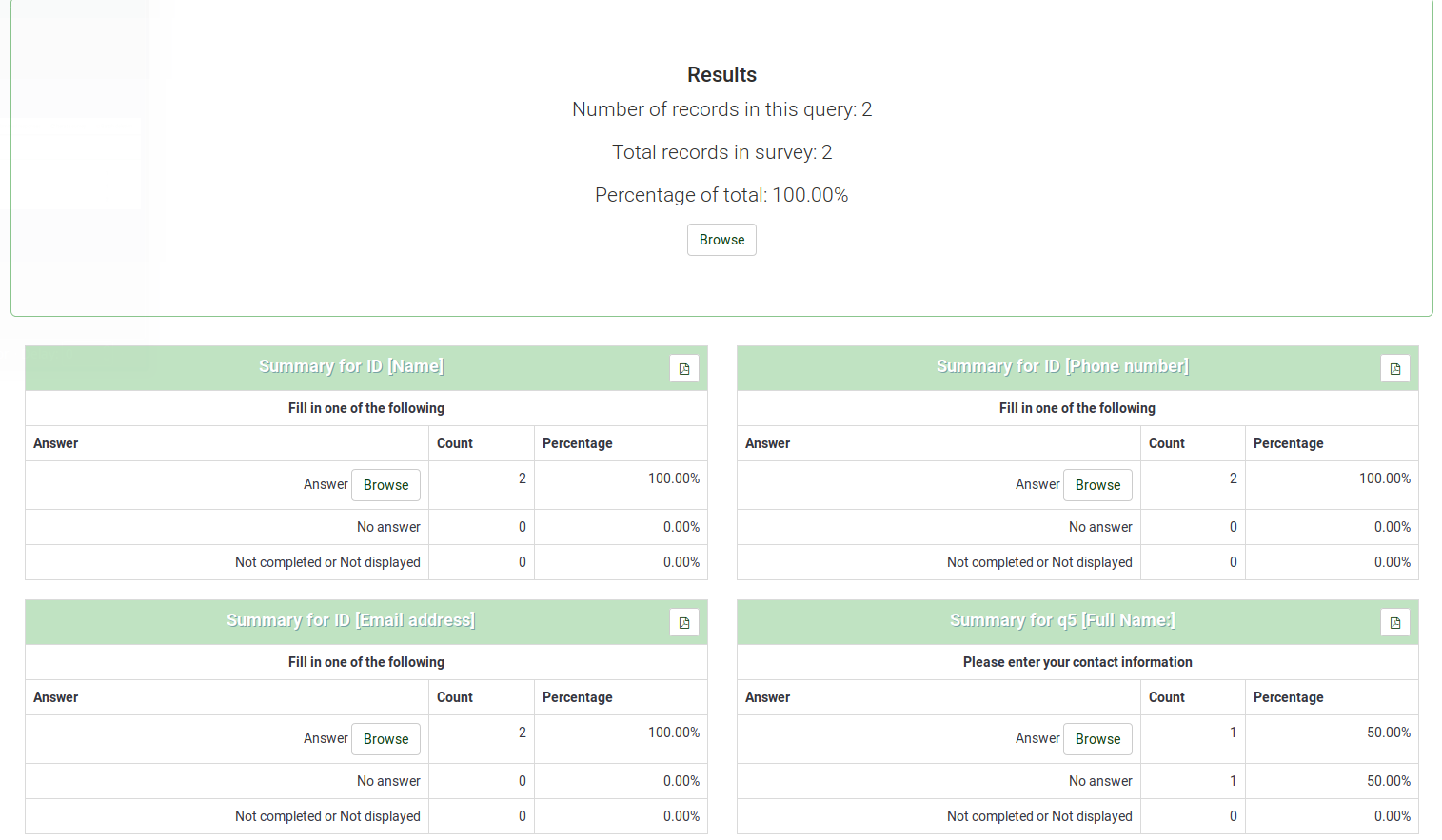
Filtrering af data
Der findes to typer filtre: generelt og svarfiltre.
Generelle filtre
Som navnet antyder, refererer Generelle filtre til filtre på det generelle (makro) niveau.
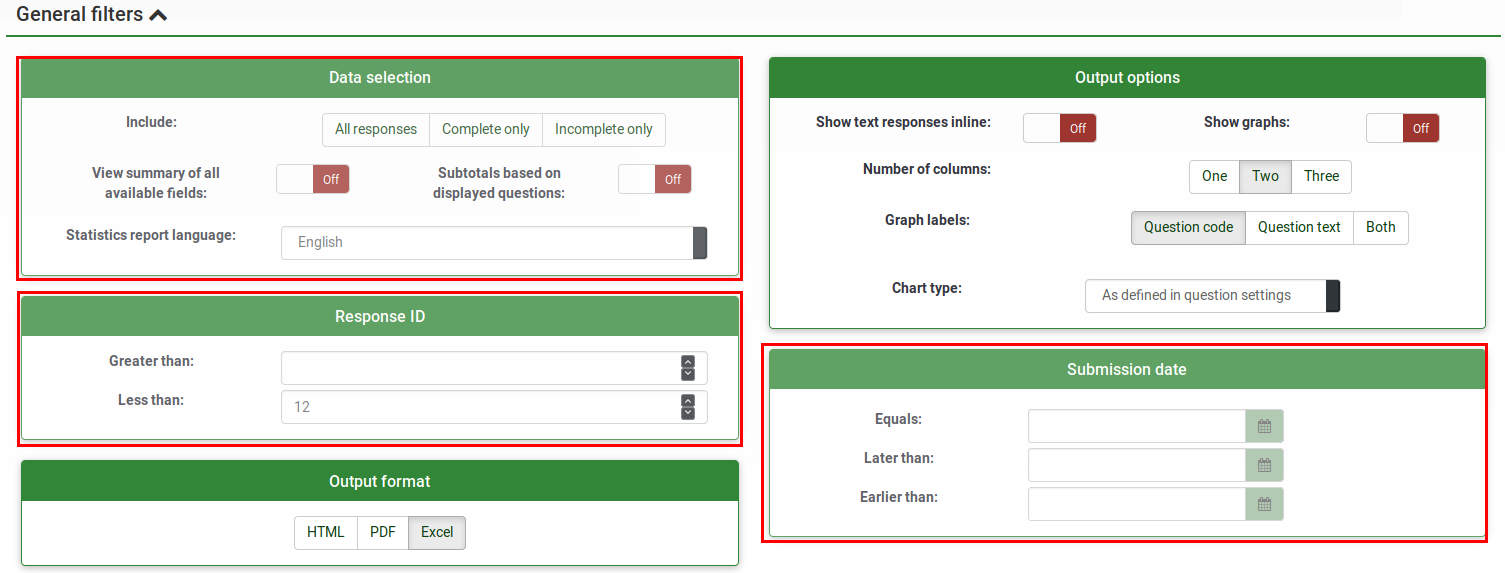
Filtrene kan relateres til:
- Datavalg
- Typen af svar:
- Fuldstændige svar: svar, der indeholder en indsendelsesdato
- Ufuldstændige svar: svar, der gør ikke indeholde en indsendelsesdato
- Alle poster: det samlede antal af komplette og ufuldstændige svar.
- Statistikrapportsprog: Hvis der bruges flere sprog, er denne filterindstilling nyttig til at dividere deltagere baseret på det sprog, de brugte til at udfylde undersøgelsen..
- Typen af svar:
- Se oversigt over alle tilgængelige felter: Slået fra som standard. Ved at aktivere det, vil alle undersøgelsens spørgsmål og grupper blive taget i betragtning, når du kører statistikscriptet
- Subtotaler baseret på viste spørgsmål: Deaktiveret som standard. Det tæller statistikker for hvert spørgsmål kun baseret på det samlede antal svar, som spørgsmålet blev vist for (god måde at filtrere de ufærdige/ufuldstændige svar).
- Svar ID: Brug ID-nummeret til at filtrere dine indsamlede svar
- Afsendelsesdato:Vises kun, hvis timings er aktiveret. Du kan filtrere dataene baseret på indsendelsesdatoen for dine indsamlede svar.
For kun at få svarene filtreret i henhold til generelle filtre, skal du aktivere indstillingen "Se oversigt over alle tilgængelige felter" og klikke på knappen Se statistik, som er placeret i øverste højre del af skærmen.
Svarfiltre
Afhængigt af den anvendte spørgsmålstype, kan forskellige felter bruges til at filtrere dine svar:
- By response: Click one or more responses in the list under each question to filter the data by those responses (use CTRL/click to select multiple responses in the same question). Note that if you choose to view the summary of all available fields (checkbox at top) you will need to select your response filters before checking that box.
- By text:You can search the responses to a free text question type (and similar types) by entering a text. If you want to search for a partial string you can use the percentage sign (%) as wildcard. E.g.: If you look for 'Tom%', it will find entries with 'Tomb' and 'Tommy', etc.
- By numerical value: You can search the responses that contain a certain numerical value if number-based question types are used.
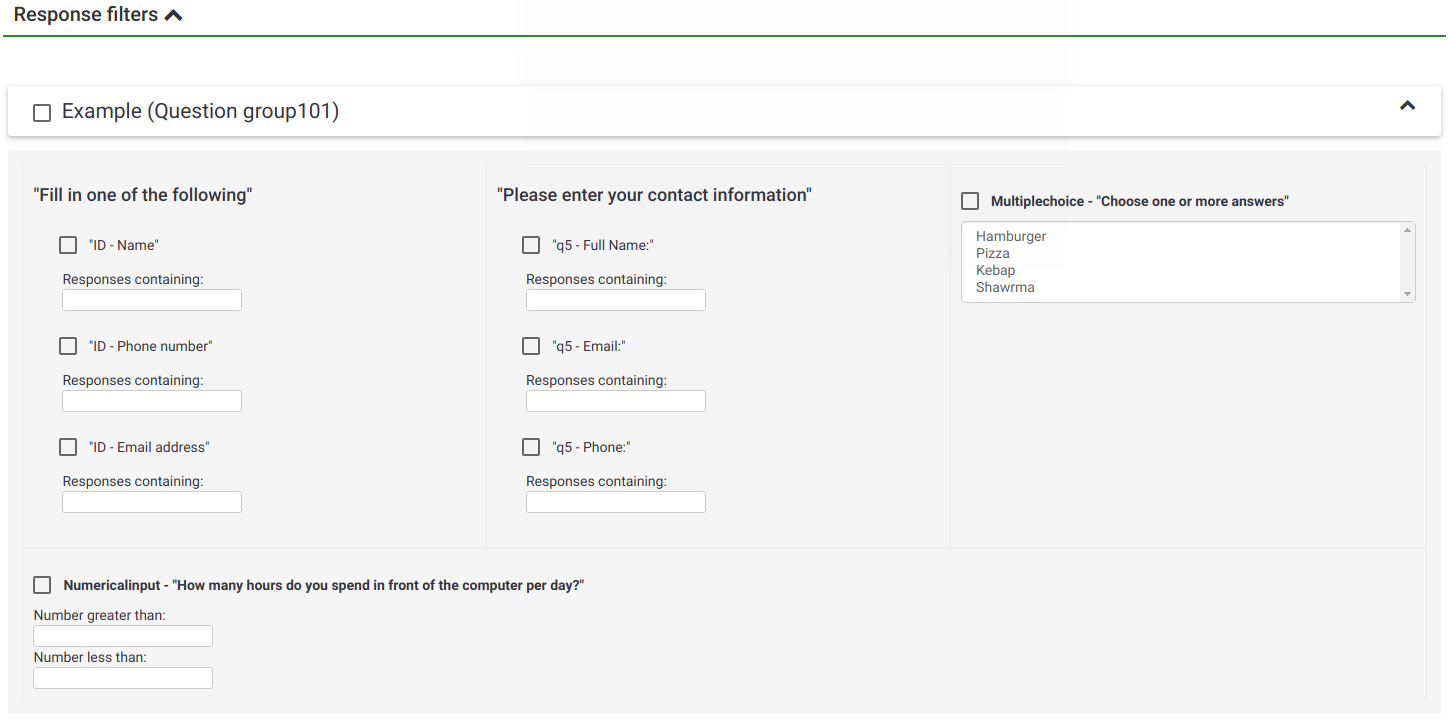
Selecting View statistics will then give you the Results table, indicating the number of responses matching your criteria, and a Field Summary table for each question selected which summarizes all possible answers in the question(s), their totals and their percentage. It is important to note that these results are a subset of your total responses. So, for example, if your criteria display 146 records out of a total 180, the summary will show the breakdown of just those 146 records for that table.
The images below indicate that the user has elected to view the stats for "Employment status" of completed records/female/age 18-25. This gives returns the results for 6 out of 13 records.
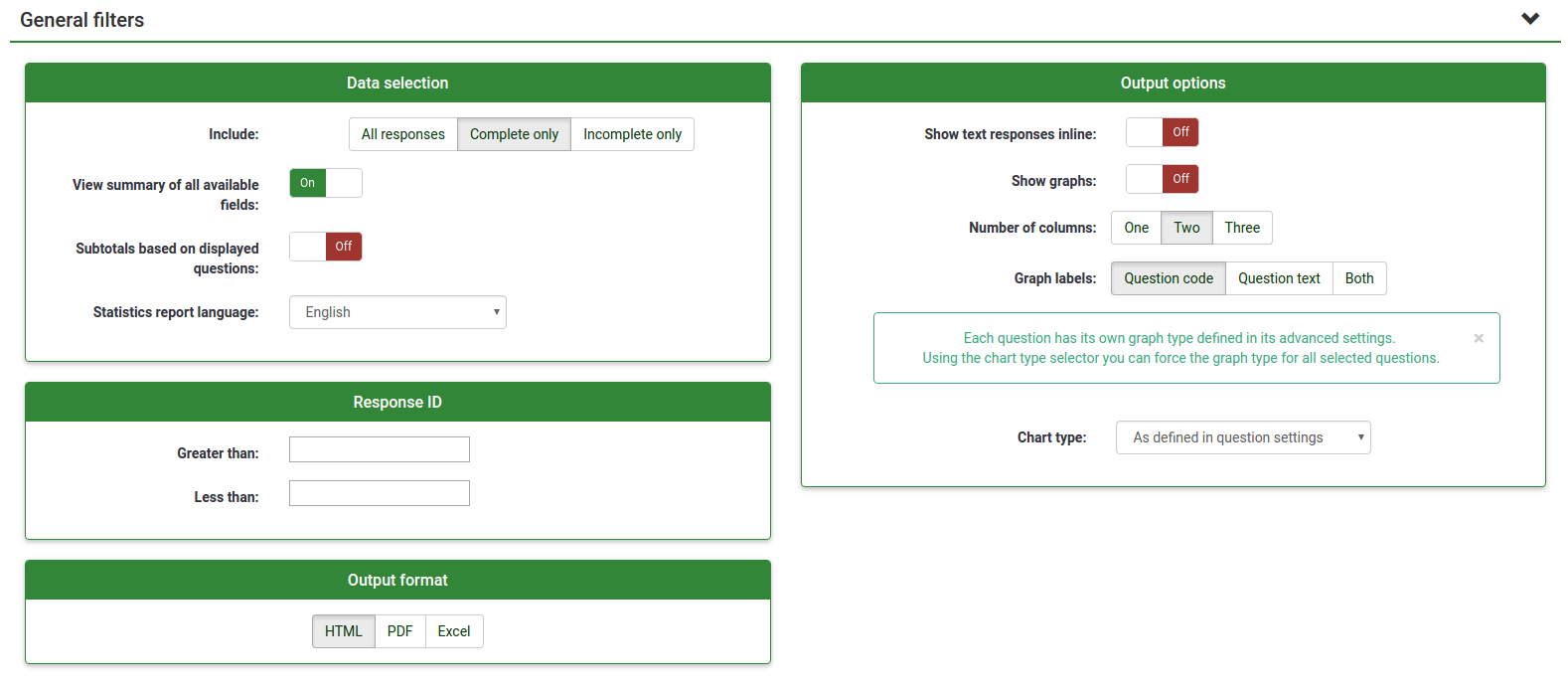

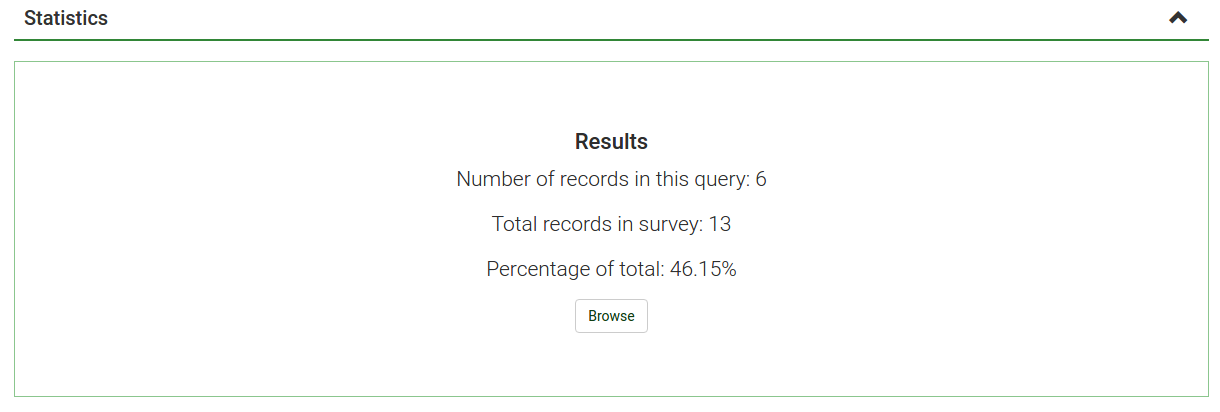
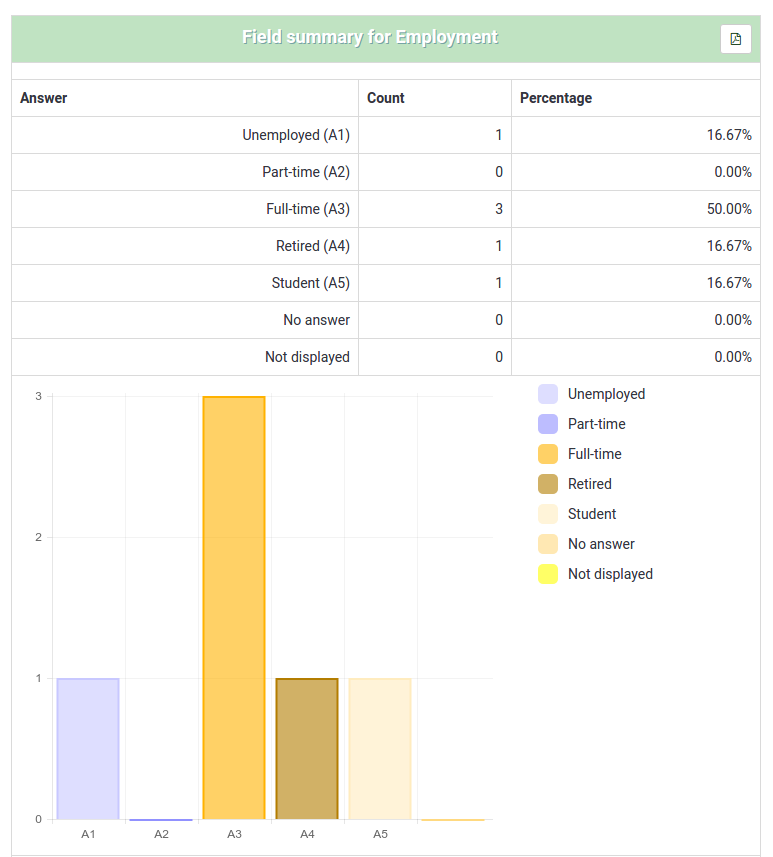
- If you set criteria on the same question that you ask for a summary, then that question will only present answers matching your criteria. So it is good practice not to set any criteria on the same question you are getting a summary of.
- To select multiple entries for a question hold down the CTRL button when clicking. To "unselect" the last criteria (if you want to clear all criteria from a question) click on the respective highlighted answer while holding pressed the CTRL button.
Graphs
For charting, the library pChart is used, which is completely included and usually doesn't have to be configured.
After the graphs have been generated you can export them easily. Right click on graph and choose "Save image as", then save the graph as a .png file to your chosen location.
You can also use the "Export images" function to save all the graphs.
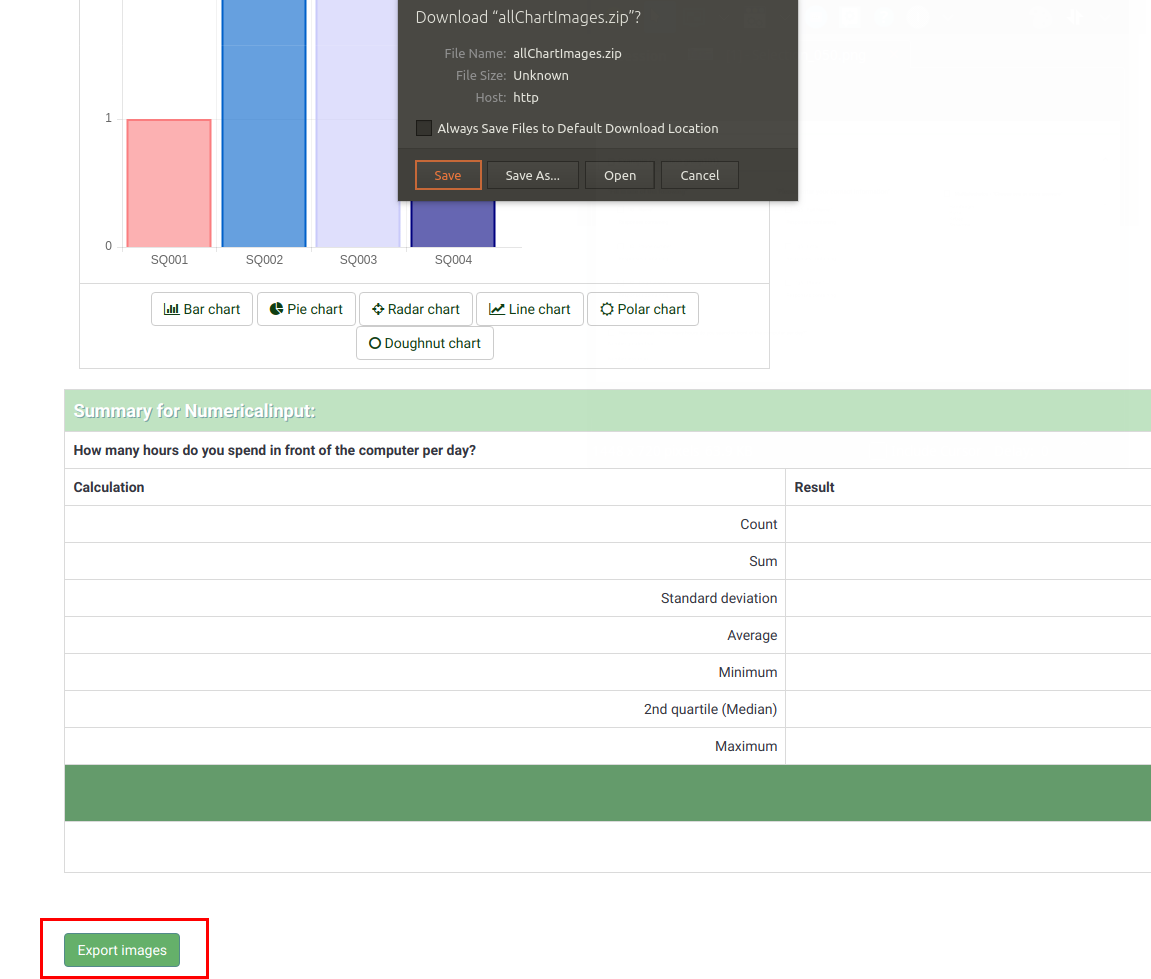
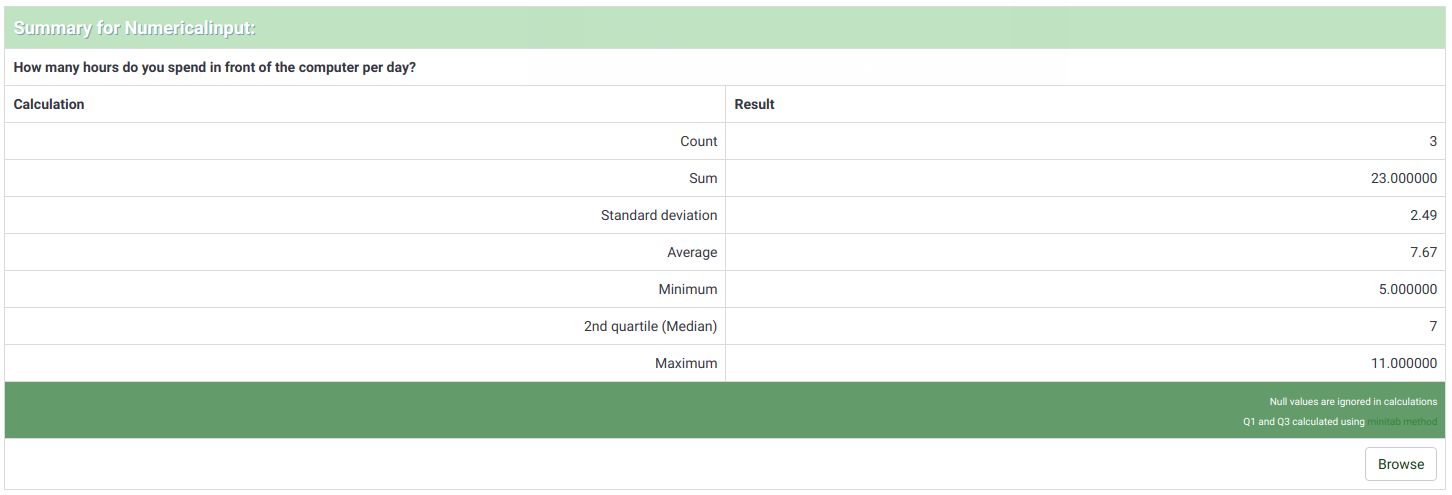
"Incomplete responses", "no answers" and "not completed/not displayed" count
- incomplete responses: All questions started but not completed - the participant clicked the "Next" button in the survey, but did not click the "Submit" button (did not land on the end page of your survey).
There is no SubmitDate in the response table for this entry, but new data set was created already.
- no answer: The question was displayed, but the participant did not an answer.
The question is not mandatory, was displayed, received no answer and the user clicked "Next" or "Submit". The consequence is that the database field for this answer is set to "" (empty string). This "no answer" status cannot be really computed for "Date" or pure "Numerical questions" where the database field cannot record a string.
- not completed/not displayed: The page containing the question was not displayed. This can be because of conditions, or because the participant left the survey before this page was displayed (or while this page is displayed, but without clicking the Next button).
The database field for this question is filled with a NULL value.
Output format and options
The statistics can be displayed in three different formats:
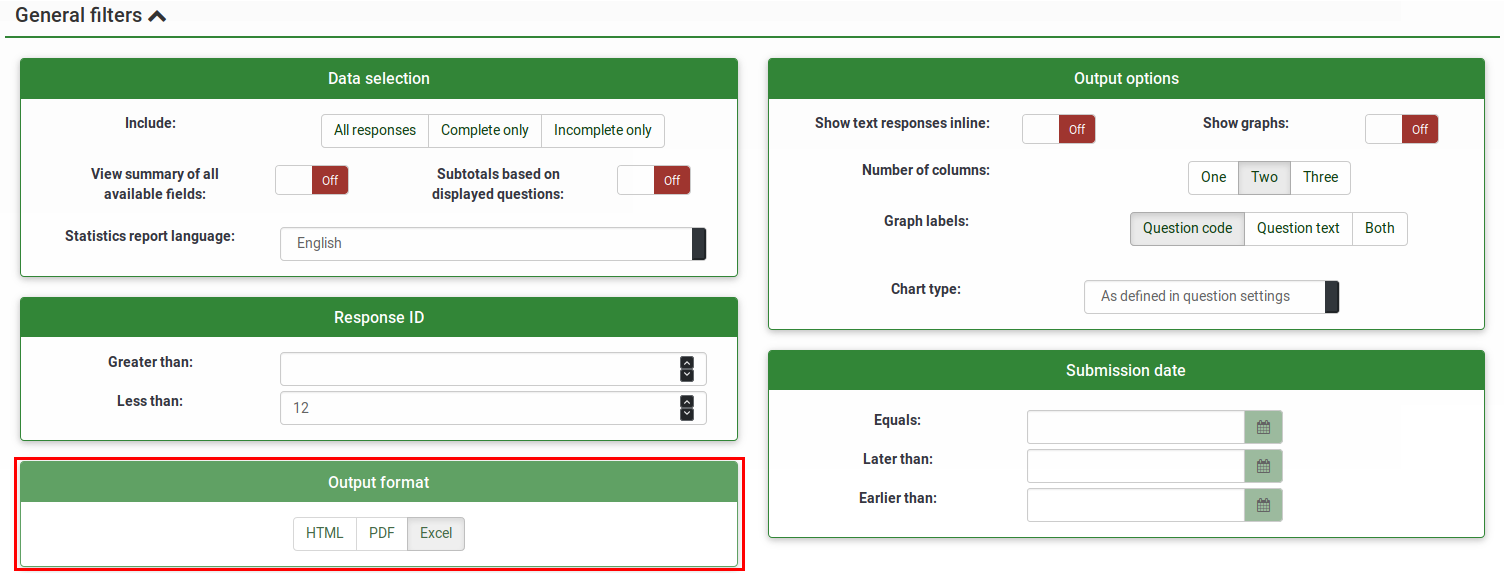
- HTML (default option): The statistics are displayed in LimeSurvey.
- PDF: A popup will be displayed, asking to save the statistics as a PDF file.
- Excel: To further work with your (filtered) data, choose Excel. You can export the file from a spreadsheet application to CSV to work with more advanced statistical tools such as SPSS or R.
The output options can be used to alter the way the statistics are displayed. The following options are available:
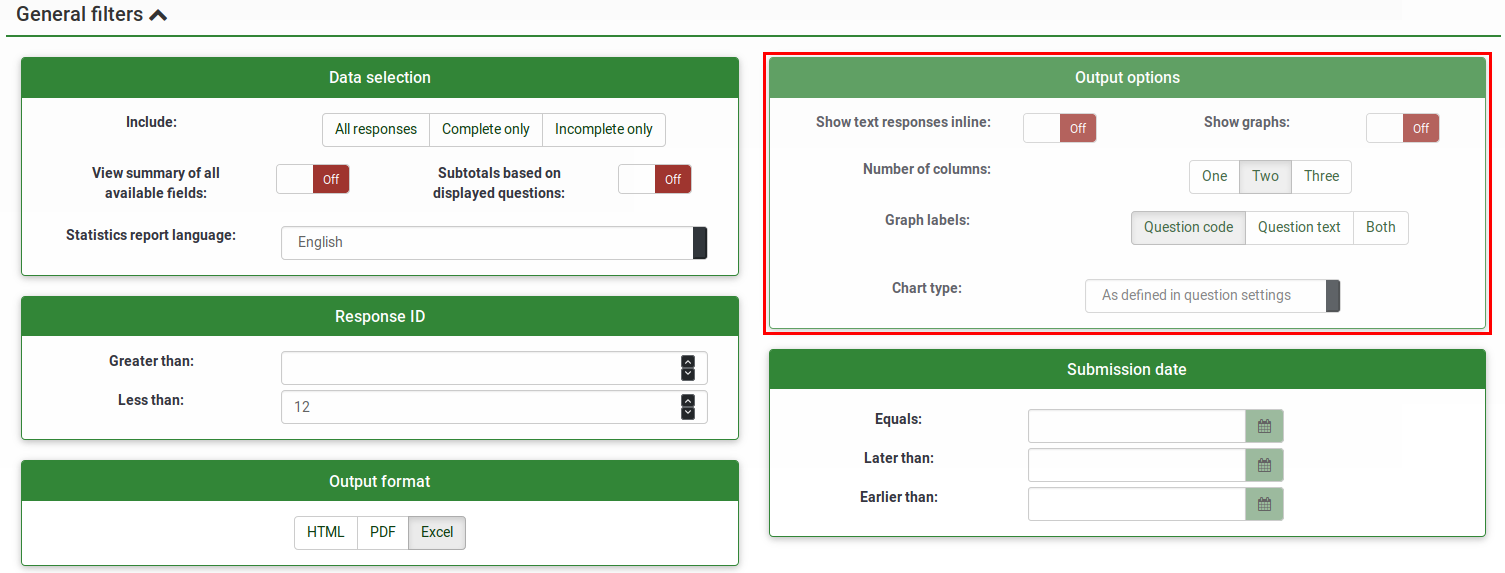
- Show text responses inline: Disabled by default. Shows the text questions responses without having to click a browse button (if enabled; useful for the HTML version of output format)
- Show graphs: Disabled by default. If enabled, graphs will be displayed.
- Number of columns: Two is the default number. If you wish to have statistics and graphs displayed on only one or three columns, choose the desired value from this option. It applies to HTML statistics.
- Graph labels: Choose how the label should look in the graph.
- Question code
- Question text
- Both
- Chart type: the following chart type settings are available:
- As defined in question settings: Useful if you do not want the graph to be displayed. If this is the case, deactivate it from the question settings and select from the "Statistics" panel this option.
- Bar chart
- Pie chart
- Radar chart
- Line chart
- Polar chart
- Doughnut chart
Embed custom logo at statistic PDF
If you want to embed your own logo to the statistics PDF, make sure a file specifically named "statistics.jpg" is placed within the "images" folder of the admin theme used for your system. The admin theme that you would like to use can be set in Global Settings.
Statistics - simple mode
The simple mode was created to provide simple bar chart statistics that can be quickly exported and saved, and then included into a presentation:
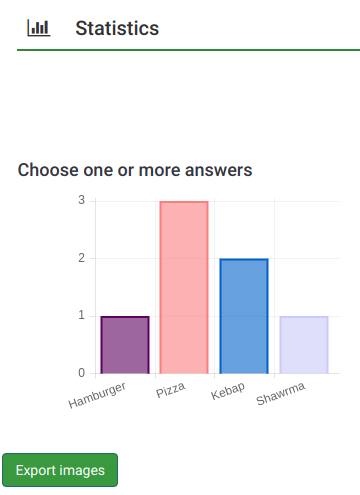
Fewer graphs are displayed than in the expert mode. While in the export mode you can display graphs with respect to those who filled out the survey, did not answer it or did not complete it. the simple mode displays only statistics that rely on the "countable" data submitted by the participants (e.g., single or multiple choice questions as well as array questions).
There is only one option to filter the data within the simple mode - via the responses to be included in the statistics. As a result, the statistics may include the complete responses, incomplete responses, or all responses (the aggregated sum of the first two options). This option is located in the upper-right part of the panel.
To switch back to expert mode, click the "Expert mode" button located in the upper-right part of the screen:

Public statistics
LimeSurvey includes the functionality to display simple statistics to the general public or to your participants after they have completed an online survey.
Two components need to be enabled to activate and display statistics to your participants. The first one refers to the public statistics of your survey which must be enabled (it is turned off by default). It is located under the Presentation tab. To also show graphs, look on the same page for the Show graphs in public statistics attribute and enable it (it is disabled by default).
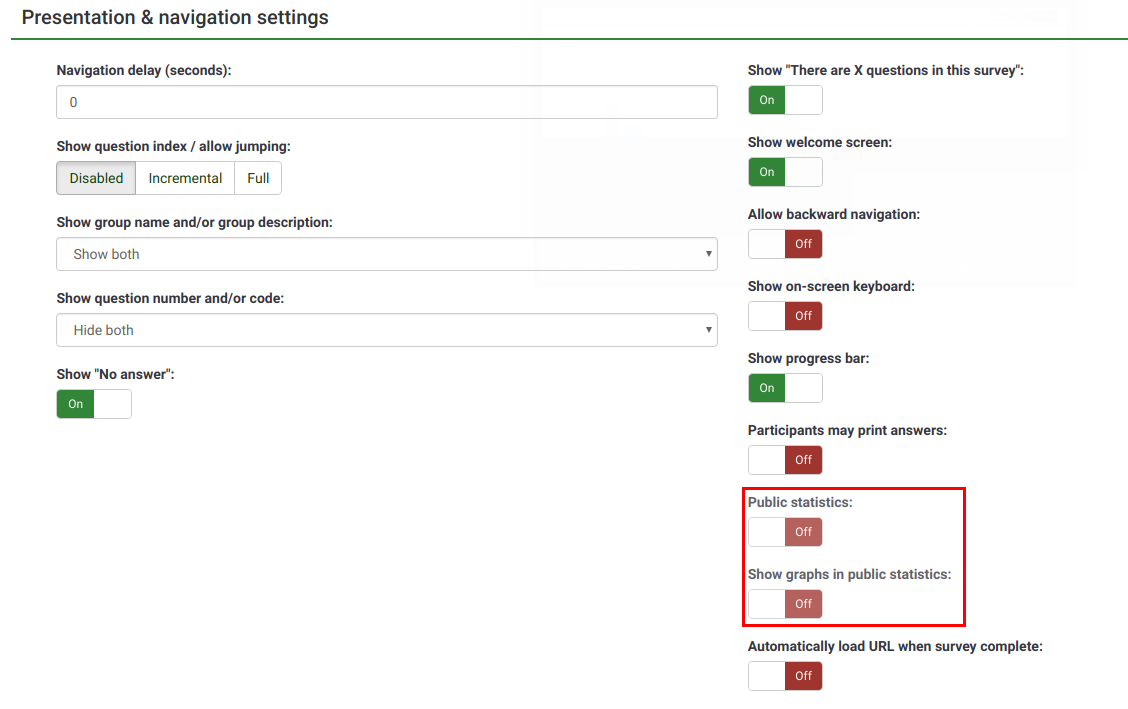
Once you have set your survey to display statistics, you need to indicate question-by-question which statistics you want to be displayed to your respondents. By default, no questions will be displayed. To have them displayed, access the desired question, look for the "Statistics" tab and enable the Show in public statistics attribute.
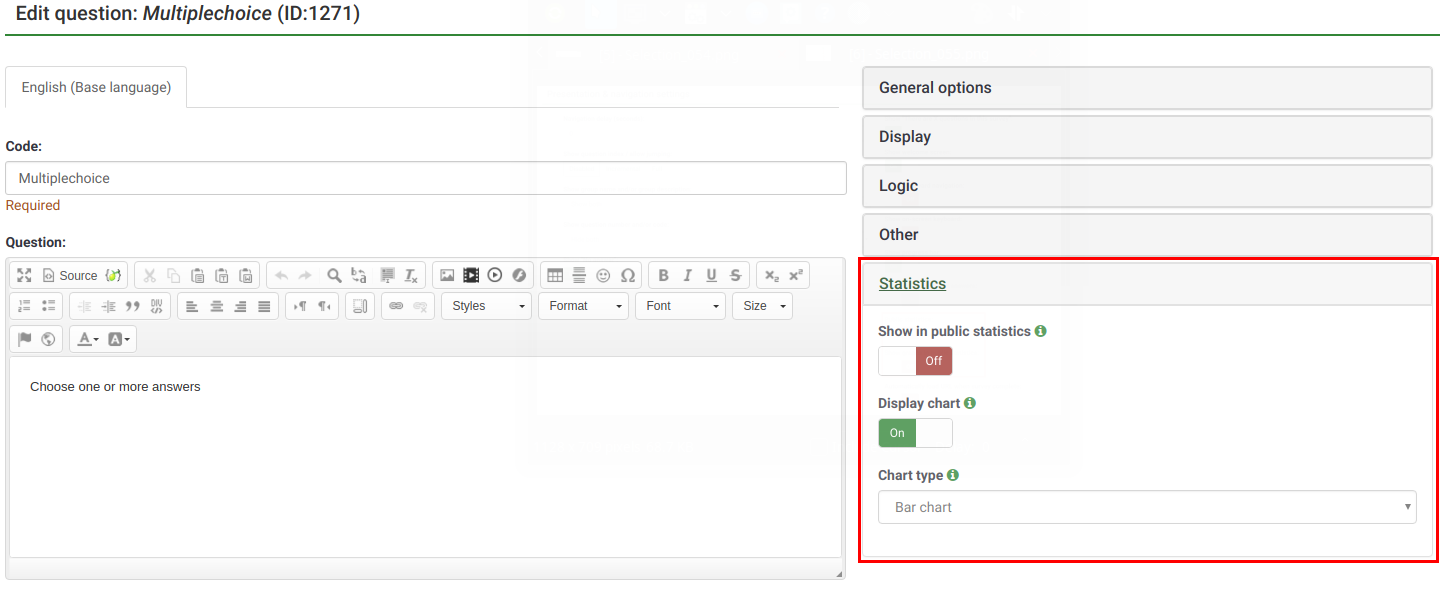
What participants see
Once you have enabled public statistics and selected some questions to display, an additional option will be visible to participants when they complete your survey. In addition to the usual thank you, there will be a link to "View the statistics for this survey":

The survey statistics will be displayed on this page. Graphs can also be displayed by enabling the Display chart question attribute:
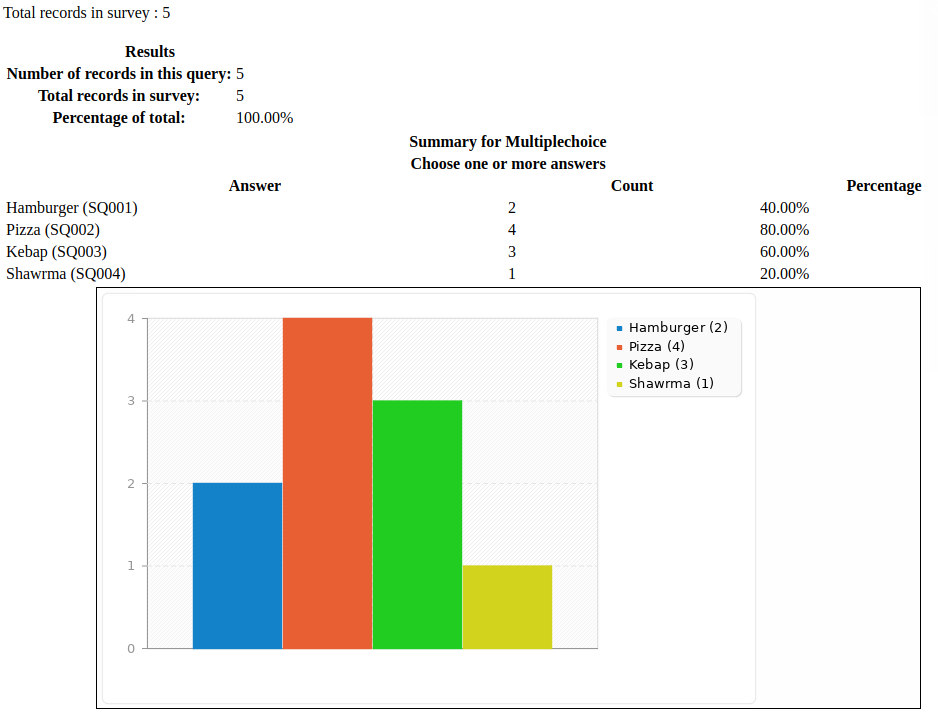
Changing the look of the public statistics page
The apprearance of the public statistics page can be modified via template.css (search for "#statsContainer"). However, there is currently no template on it's own that can be edited in the LimeSurvey theme editor.
Hints & tips
Feel free to edit the following wiki sections to let other LimeSurvey users learn about statistics-related hints & tips.
Wrong font when exporting statistics - what to do?
For some languages (like Chinese), the usual font used (Vera) does not cover the needed character set. In that case you can use the setting $chartfontfile to set a new TTF font file in config.php (Check out config-defaults.php for the right setting). For Chinese (Simplified and Traditional), another font has to be used such as the FireFlySung font which can be downloaded from github.
FAQs
5 Point choice question type - what do the values located under the "sum" column represent?
In the screenshot below, notice that the "Sum" column shows the aggregated values in the following way:
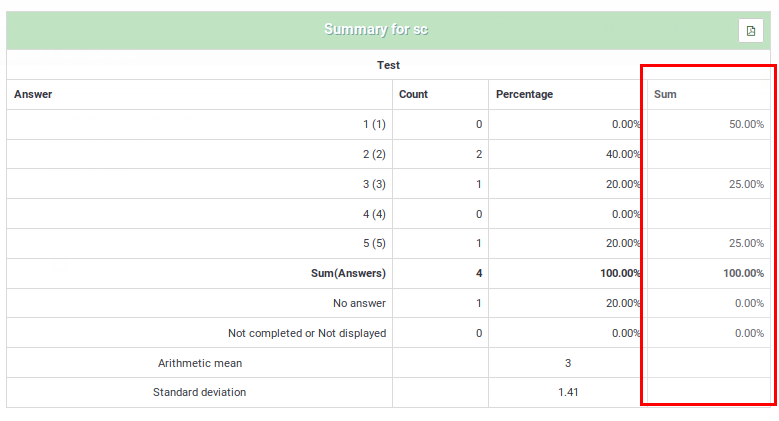
The grouping from the "Sum" column was done in this way because, when rating questions, survey administrators usually interpret the results in this way:
- Y percent of the participants DISLIKE item ABC, where Y represents the percentage of those who answered "1" and "2"
- X percent of the participants LIKE item ABC, where X represents the percentage of those who answered "4" and "5"
- Z percent of the participants have a NEUTRAL opinion about item ABC, where Z represents the percentage of those who answered "3"
| Answer | Count | Sum |
|---|---|---|
| 1 | 0 | 50% (the percentage of those who answered "1" and "2") |
| 2 | 2 | |
| 3 | 1 | 25% (the percentage of those who selected "3" - the neutral option) |
| 4 | 0 | |
| 5 | 1 | 25% (the sum of those who answered "4" and "5") |
| Sum (Answers) | 4 | 100% |
| No answer | 1 | 0% (always "0%") |
| Not completed or displayed | 0 | 0% (always "0%") |